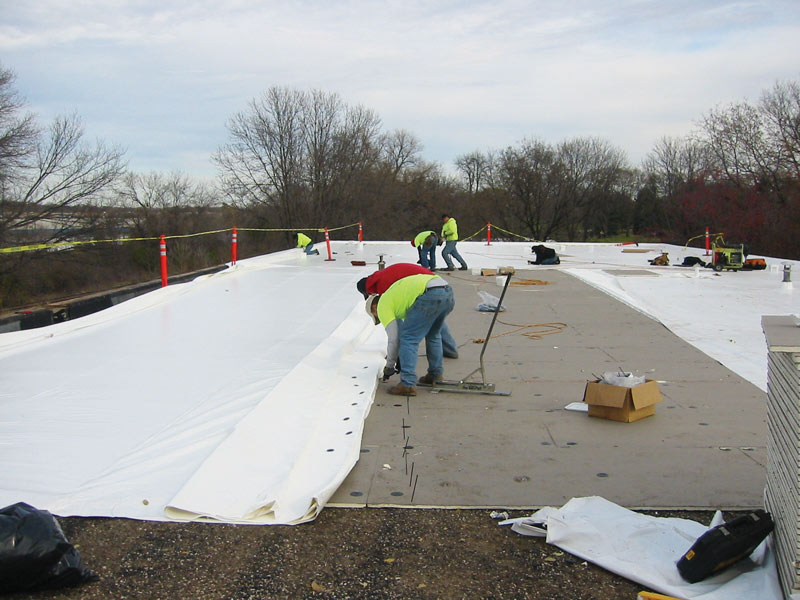
A crew from roofing contractor All Elements Inc. installs the white roof atop Minnesota Valley Country Club’s maintenance facility. Photo courtesy of Mike Brower
For summer days spent inside the un-air-conditioned maintenance facility of Minnesota Valley Country Club (MVCC) in Bloomington, Minn., Mike Brower describes his former stay-cool strategy with a sigh: “Lots of fans.”
Before 2010, the temperature in the space where some employees log seven hours a day would regularly climb to uncomfortable heights. It wasn’t until the then-26-year-old building’s roof began to leak that Brower, the GCSAA Class A superintendent at Minnesota Valley and a 27-year association member, was able to seize upon an idea to soften the swelter: a white roof.
“We needed a new roof because of the leakage, but at the same time, we wanted to be proactive about the building’s temperature by putting in a white roof that would reflect the sun’s energy,” Brower says.
The concept is simple: Light colors reflect light, while dark colors absorb it. Many of us are mindful not to don dark attire on a hot, sunny day in order to keep as cool as possible. Similarly, for sky-facing surfaces such as roofs, a lighter hue will pass along less heat to the space below.
For an AC-free building such as Brower’s, the swap from dark to light on the structure’s cap can drop the internal temperature as much as 10 degrees Fahrenheit, says Heather James, a board member of the White Roof Project, a New York City-based nonprofit dedicated to funding and spreading the word about white roofs. For buildings in climates with consistently hot days, James says white roofs can achieve as much as a 40 percent reduction in cooling costs.
Type of climate is a huge factor in the effectiveness of any white roof, but James says the tactic does make sense in northern regions despite the seemingly logical assumption that buildings would benefit from the extra warmth come winter. “You do get some heat impact from a black roof in winter, but not as much as you’d necessarily think,” says James, who cites the less direct angle of the sun, fewer hours of sunlight and snow cover as circumstances that slash the perceived wintertime advantage of a dark roof.
And while white roofs (also known as “cool roofs”) garner much interest because they lessen financial costs, the naturally cooler spaces they create translate to reduced environmental costs as well. “Every time you crank up fans or crank up the air conditioning, you’re using a lot of electricity,” James says. “When you cut your electricity use, you cut the carbon dioxide emissions generated by the power plant.”
At MVCC, the black-tar-and-gravel “built-up” roof on the 12,000-square-foot maintenance facility was replaced with a white roof in fall 2009 by All Elements Inc., a roofing contractor in Monticello, Minn. The new system is a Duro-Last single-ply, 40-mil vinyl membrane, which is a lone sheet of specially formulated material that never gets more than 10 degrees warmer than the ambient temperature, says Dan Jernberg, an estimator and roof consultant with All Elements.
In addition to their personal-comfort and planet-conscious merits, white roofs offer a few more perks. Because they don’t overheat, they’re less prone to warping and cracking, which means fewer repairs and a longer life span. Perhaps the best part? “The cost is right in line with other types of roofs,” Jernberg says. “Every time we go up against a proposal for a built-up roof, the Duro-Last white roof typically beats that price by about 25 percent.”
Brower says his almost-6-year-old white roof, which was comparable in cost to what a roof identical to the old one would have run, has held up nicely, and that a lower indoor temperature was immediately noticeable. So pleased is he that when the time rolls around to replace the roof on MVCC’s nearly 20-year-old clubhouse, another white roof is a strong possibility. “Why not do our part for the environment while at the same time getting the new roof we need? It’s a win-win,” says Brower, who is in his 14th year as superintendent at the club.
Minnesota Valley is a Certified Audubon Cooperative Sanctuary, and also counts among its sustainability efforts having all food waste picked up by a local farm to be transformed into compost.
“We’re committed to the environment, and that has always motivated us to think about, with anything we do, how we can be more sustainable and environmentally friendly,” says Brower, who encourages other superintendents to explore white roofs as an option for increased interior comfort and decreased ecological impact (find more info and a cost-savings calculator on the Energy Saver website). “Roofs are something that you don’t often get up on, and if it’s out of sight, it tends to be out of mind,” Brower says. “Many people may not realize the opportunities that are right up on their roof.”
Megan Hirt is GCM’s managing editor.